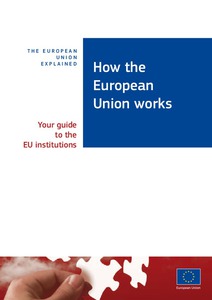How the European Union works. The European Union explained: your guide to the EU institutions
"This publication is a part of a series that explains what the EU does in different policy areas, why the EU is involved and what the results are. You can see online which ones are available and download them at: http://europa.eu/pol/index_en.htm. The European Union (EU) is unique. It is not a...
| Institution: | ETUI-European Trade Union Institute |
|---|---|
| Format: | TEXT |
| Language: | English |
| Published: |
Luxembourg
2012
Publications Office of the European Union |
| Subjects: | |
| Online Access: | https://www.labourline.org/KENTIKA-19120181124919483639-How-the-european-union-works.-.htm |
| Summary: | "This publication is a part of a series that explains what the EU does in different policy areas, why the EU is involved and what the results are. You can see online which ones are available and download them at: http://europa.eu/pol/index_en.htm. The European Union (EU) is unique. It is not a federal state like the United States of America because its member countries remain independent sovereign nations. Nor is it a purely intergovernmental organisation like the United Nations because the member countries do pool some of their sovereignty — and thus gain much greater collective strength and influence than they could have acting individually. They pool their sovereignty by taking joint decisions through shared institutions such as the European Parliament, which is elected by the EU citizens, and the European Council and the Council, which both represent national governments. They decide on the basis of proposals from the European Commission, which represents the interests of the EU as a whole. But what does each of these institutions do? How do they work together? Who is responsible for what? This booklet sets out the answers in clear and simple language. It also gives a brief overview of the agencies and other bodies that are involved in the European Union’s work. The aim is to provide you with a helpful guide to EU decision-making " |
|---|---|
| Physical Description: | 39 p. Paper Digital |

